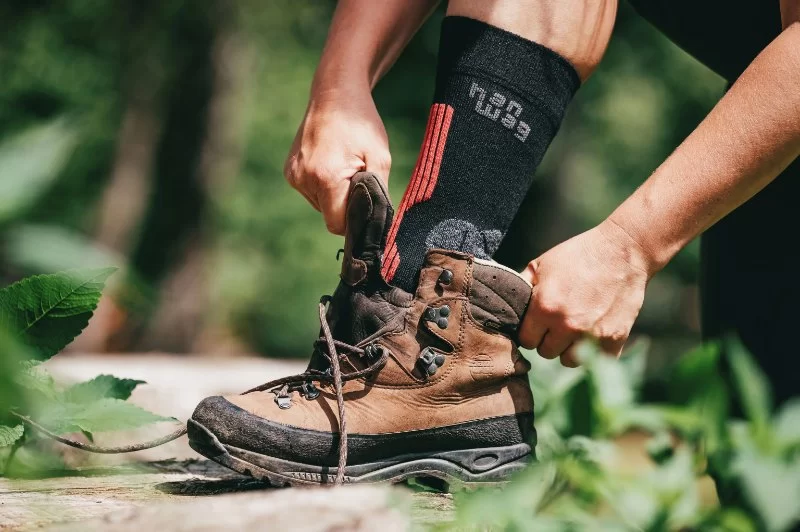- understanding-the-importance-of-hiking-socks - Understanding the Importance of Hiking Socks for Waterproof Boots
- material-matters-for-performance - Material Matters for Performance and Comfort
- fit-and-cushioning-considerations - Fit and Cushioning Considerations
- real-trail-experiences - Real Trail Experiences and Lessons Learned
- maintenance-and-care-tips - Maintenance and Care Tips for Long-Lasting Socks
- when-to-upgrade-your-socks - When to Upgrade Your Socks
Understanding the Importance of Hiking Socks for Waterproof Boots
Choosing the right hiking socks for waterproof boots can make the difference between an enjoyable trek and a painful, blister-filled ordeal. While waterproof boots keep external moisture out, they can also trap heat and perspiration inside if paired with the wrong socks. The result? Damp feet, friction, and a much higher risk of blisters. The right socks act as a moisture manager, temperature regulator, and comfort enhancer all at once.
Some hikers underestimate the role socks play, focusing only on boots. However, without proper socks, even the most advanced waterproof boots can become uncomfortable during long hikes. Good hiking socks help wick away sweat, reduce pressure points, and create a breathable layer between your skin and the boot’s lining.
Material Matters for Performance and Comfort
1. Merino Wool for All-Weather Versatility
Merino wool is a favorite among seasoned hikers because it regulates temperature, resists odor, and wicks moisture efficiently. In both hot and cold conditions, it helps keep feet dry and comfortable, making it an ideal match for waterproof boots.
2. Synthetic Blends for Durability
Polyester and nylon blends add durability and quick-drying properties. They’re especially useful in wet environments where rapid moisture evaporation is key to preventing blisters.
3. Cotton – Why to Avoid It
While comfortable for everyday wear, cotton retains moisture and dries slowly, making it a poor choice for hiking. Trapped moisture increases friction, which can quickly lead to discomfort or injury.
Fit and Cushioning Considerations
1. The Role of Proper Fit
Ill-fitting socks can bunch up, slide, or create pressure spots, all of which lead to foot pain over long distances. Choosing the right size is just as important as selecting the right material.
2. Cushioning Levels for Different Trails
Light cushioning works well for short day hikes or warm weather, while medium to heavy cushioning provides extra comfort and shock absorption on rough or cold terrain. The cushioning also acts as a buffer against the stiffer construction of waterproof boots.
3. Seam Placement and Comfort
Flat or seamless toe designs reduce friction, particularly during steep descents where toes press forward in the boot. This small detail can make a big difference on multi-day hikes.
Real Trail Experiences and Lessons Learned
On a week-long trek through the damp forests of the Pacific Northwest, one hiker shared how switching to merino wool socks mid-trip transformed the experience. Before the change, even his premium waterproof boots couldn’t prevent discomfort caused by damp cotton socks. After switching, his feet stayed dry, warm, and blister-free for the rest of the journey.
Stories like this highlight that investing in the right socks is not a luxury—it’s a necessity for anyone serious about hiking comfort. It’s why many experienced hikers recommend consulting outdoor gear specialists, such as those at Pine Cliff Resort, to get personalized advice.
Maintenance and Care Tips for Long-Lasting Socks
1. Washing Guidelines
Follow manufacturer care instructions to preserve fabric integrity. Avoid high heat drying, which can shrink or damage fibers, especially in wool blends.
2. Rotating Socks
Bring multiple pairs on longer trips. Alternating socks allows each pair to fully dry and recover, extending their lifespan and improving comfort.
3. Storage Best Practices
Keep socks in a dry, breathable bag when not in use. Avoid sealing them in airtight containers where residual moisture can lead to mildew.
When to Upgrade Your Socks
Even the best hiking socks eventually lose their cushioning and elasticity. If you notice thinning fabric, persistent odors, or reduced comfort, it’s time to replace them. Regularly upgrading your socks ensures they continue to complement your waterproof boots and keep your feet in peak condition.
For hikers looking to maximize comfort, combining quality waterproof boots with purpose-built hiking socks is the ultimate strategy. The right combination protects against the elements, supports long-term foot health, and makes every step more enjoyable.







